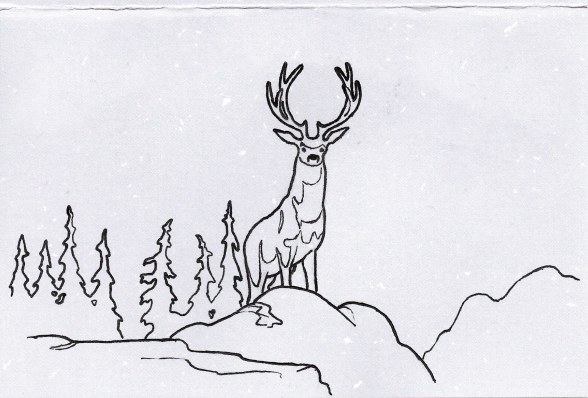Mule Deer
Odocoileus hemionus
 Mule deer are named for their large ears. They are deer of open hills and rugged slopes of western North America. In winter they often move from the hills and mountains onto valley slopes, where there is less snow. In the day they bed down in what brush is available. As evening falls they begin to move about in small groups or alone. Through the night they feed, then move back to cover at dawn. Mule deer are primarily browsers, consuming shoots, leaves, berries, twigs, conifer needles, acorns, and apples, but in summer they will often graze on grass as well.
Mule deer are named for their large ears. They are deer of open hills and rugged slopes of western North America. In winter they often move from the hills and mountains onto valley slopes, where there is less snow. In the day they bed down in what brush is available. As evening falls they begin to move about in small groups or alone. Through the night they feed, then move back to cover at dawn. Mule deer are primarily browsers, consuming shoots, leaves, berries, twigs, conifer needles, acorns, and apples, but in summer they will often graze on grass as well.
If startled, mule deer will snort in alarm and escape in a series of stiff-legged bounds called stotting. If it does not take them closer to danger they will stott uphill, moving nearly as fast as on the flats. Predators chasing them uphill or over broken ground quickly become tired and cease pursuit. After bounding off for a few hundred meters the mule deer will tend to stop and look back at its pursuer, a behavior which does not serve it well against hunters with high powered rifles.
Bucks start to grow antlers in spring. By late summer, the antlers are free of velvet and ready for use. After the rut, in autumn, the bucks have no more use for their antlers which fall off in late winter.
Bucks neither hold territories nor assemble harems in the rut. Rather, they follow and defend a single female until she is mated or until the buck driven off by another male. The young are born in spring. Fawns, typically twins, are birthed in a seculded location, where they remain for a week or two until they are strong enough to follow their mother. During this time they have very little scent, to throw off predators. Their mother returns approximately every four hours to nurse her offspring. The fawns are weaned by fall, and are on their own by spring.
A subspecies of mule deer, the blacktail deer, live on the margins of western forests along the Pacific coast rather than on open slopes, occupying the same niche that whitetail deer do in the rest of the continent.
Back to Cervids
 Mule deer are named for their large ears. They are deer of open hills and rugged slopes of western North America. In winter they often move from the hills and mountains onto valley slopes, where there is less snow. In the day they bed down in what brush is available. As evening falls they begin to move about in small groups or alone. Through the night they feed, then move back to cover at dawn. Mule deer are primarily browsers, consuming shoots, leaves, berries, twigs, conifer needles, acorns, and apples, but in summer they will often graze on grass as well.
Mule deer are named for their large ears. They are deer of open hills and rugged slopes of western North America. In winter they often move from the hills and mountains onto valley slopes, where there is less snow. In the day they bed down in what brush is available. As evening falls they begin to move about in small groups or alone. Through the night they feed, then move back to cover at dawn. Mule deer are primarily browsers, consuming shoots, leaves, berries, twigs, conifer needles, acorns, and apples, but in summer they will often graze on grass as well.